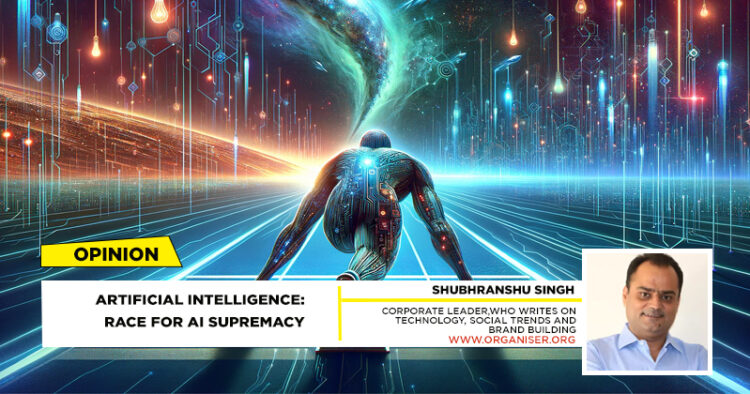The world has never seen a technological disruption of the scale and pervasiveness of Artificial Intelligence. Who will emerge victorious in this race for AI supremacy? The commercial prize will go to that efficient model-builder which has a core capability to produce and weld together data and takes an early lead in branding. That prize is humongous wealth creation.
But, what about AI leadership at a national, civilisational level?
There the prize is world mastery.
No wonder President Biden has issued an executive order with an aim to regulate how U.S. companies develop AI and how regulators oversee it. The order will create standards for American companies and public agencies. The ‘Defense Production Act’ authorises the American President to mobilize U.S. industry to support national defence. The US aims to remain the global leader in regulating the fast-growing tech, with the British government hosting an international summit meeting on AI safety on November 1 and 2, 2023 where more than 100 world leaders, tech honchos, global power hitters including Elon Musk were in attendance. Perhaps the discussions may lead to an institutional arrangement like the Intergovernmental Panel on Climate Change.
No technology has greater future significance than artificial intelligence. America and China are engaged in an all-out contest for technological supremacy. Bharat must strengthen basic research to compete with and beat international competitors and to ensure a high level of self-reliance and self-improvement.

We must pay close attention to the foundational models which enable generative AI. Here America is the clear leader. ChatGPT is from OpenAI, an American startup now partly owned by Microsoft. Smaller, more focused American companies like Anthropic, StabilityAI are just as advanced as Google, Meta and Microsoft . The Chinese firm Baidu has created Ernie, a rival to ChatGPT. China’s tech titans -Alibaba and Tencent- have not yet commercially ventured into generative AI.
Data, hardware and expertise — this is what it takes to win the AI game as a nation.
CHINA VS AMERICA
Let us assess how the China vs America race is positioned. The Americans have an edge in data sources since foundation models are trained on the voluminous unstructured data of the web and more than half of all websites are in English. Most Chinese access the internet via mobile super-apps like WeChat and Weibo. Much of this content is not indexed on search engines. Experts have rated Wu Dao 2.0, from the Beijing Academy of Artificial Intelligence, as being computationally more complex than gpt-4 but a model feeds on underlying data and here China models lag. America has imposed export controls on hardware technology such as powerful microprocessors that China needs in cloud-computing. Without that ability, foundational models cannot do learning. The hardware required for chipmaking is most critical. The world of AI is built on a foundation of semiconductors. The Chinese are dependent on Nvidia, an American chip designer, for their processing power. SMIC is much behind TSMC, the Taiwanese industry leader that manufactures chips for Nvidia.
America also attracts talent from across the world. China does not have a foreign student population or expatriate highly skilled tech workers. If at all, there is a talent drain from the East to the West.
New generative AI models are being developed too quickly. Large language models by tech giants like Alphabet, Amazon and Nvidia such as Palm, Megatron, Titan and Chinchilla are getting iterated fast.
BHARAT’S STRENGTHS
Bharat, as the world’s largest democracy, must shape frontier technologies such as AI in its journey towards becoming a great economic and military power in the world.
We have put digital technologies at the core of our inclusive development. We can make the AI evolution very different with social empowerment and inclusion at the core. Our public and private sectors have produced AI-powered tools that improve the delivery of health and security services, affecting millions of lives. Like in the case of financial inclusion and payment technology, even in AI we can become the world leader.
India AI, the national AI portal, the YUVAi programme for skilling students from government schools are important initiatives in this direction. The groundwork in the form of the National Semiconductor Mission, the National Data Governance Framework Policy and the New Digital Personal Data Protection Bill is coming in place.
We possess the right strengths related to AI technologies – talent, private sector participation and research capability. In 2020, Bharatiya companies were ranked second in AI adoption in the Asia Pacific. Bharat has also established itself as an AI research and innovation powerhouse. Since 2010, we rank as the fourth largest producer of AI-relevant scholarly papers and 8th in the world regarding AI patents filing.
As per Nikkei Asia and the Stanford AI Index, China and the United States are neck-to-neck as leaders in paper citations, global conference publications. China has the biggest model size in Tongyi whereas America leads commercially with a smaller GPT 4 model. But America is many multiples ahead of China in leading edge chip transistors and in private investment.
Bharat must mind these markers of performance and learn from the current to race ahead.



















Comments